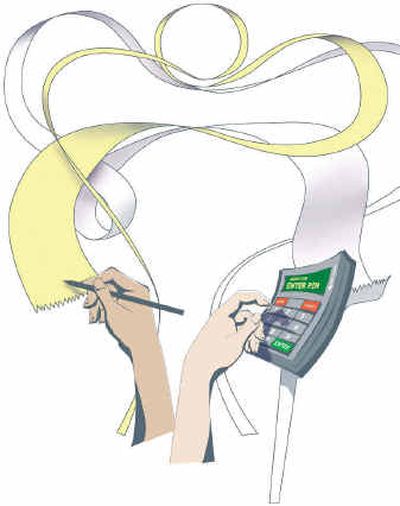Plastic predicament

PIN or sign?
Although many shoppers don’t realize it, they are in the middle of an invisible tug-of-war between credit card companies and major retailers in an increasingly cashless society. Whether a customer uses a PIN code or signs his or her name when using a bank-issued card affects the size of the fee the merchant must pay.
In the few seconds it takes to decide how to use their cards, shoppers collectively decide the fate of billions of dollars in fees.
Electronic payments surpassed the use of cash and checks for the first time last year, according to a study by the American Bankers Association, a Washington trade group, and Boston-based Dove Consulting. Cash and checks accounted for 47 percent of consumer purchases in 2003, down from 51 percent in 2001. Just five years ago, cash and checks still accounted for 57 percent of purchases, the study found.
Banks increasingly offer their customers cards that automatically withdraw money from a checking account at the point of purchase.
Debits, accessed with a PIN code, instantly withdraw money from a customer’s account for a purchase.
On the other hand, when the customer signs for his purchase, the money is also withdrawn from the customer’s account but it moves through the Visa USA or MasterCard International networks and typically takes a few days.
Although the signature-based purchase uses the credit-card networks and is commonly referred to as a “credit” option, it isn’t a true credit card purchase that allows a consumer to pay off the balance over time. Visa and MasterCard added their brands in the check-card field in the mid-1990s as consumers began to rely less on their traditional credit cards.
Retailers often prefer that customers use their PIN, thus activating the debit portion of their cards, because transfer fees associated with those purchases — routed through regional debit networks — cost the stores from 18 cents to 65 cents per transaction. On the other hand, a signature-based debit transaction, which goes through Visa and MasterCard’s networks, can cost the merchant more than $1 per transaction.
Technology is making it easier for merchants to prompt shoppers to use their PINs. And retailers have stepped up their efforts to coax customers to do so since Wal-Mart, the world’s largest retailer, settled a lawsuit with Visa USA and MasterCard International last year. That settlement extended the influence stores have over payment options.
“We definitely are telling consumers to use their PIN because it’s a more secure transaction that is cheaper for retailers and one that holds down prices for consumers,” said J. Craig Sherman, vice president of public relations for the National Retail Federation in Washington.
Bank-card providers counter that the “signature” option offers more security and is more widely available for use in stores — part of their justification for charging merchants more for signature-backed purchases.
“Certainly we think there’s more value in a signature transaction,” said Rosetta Jones, director of Visa USA.
But industry experts acknowledge that revenue for the entity that carries the transaction is a large factor.
“A lot of banks encourage people to use signature-based more often because it’s much more lucrative for the bank,” said John Hall, a spokesman for the American Bankers Association.
Both sides are using subtle and not-so-subtle ways to steer consumers in their direction.
Charlotte, N.C.-based Wachovia began last month to offer “Visa Extras” to its more than 6 million check-card holders. Customers can earn points for using their check cards, but only if they sign for the transaction. Users get a point for every dollar spent and can trade in points for discounts at select retailers.
At a BJ’s Warehouse Club in Bel Air, Md., stickers on the swipe machines at the self-serve registers suggest that customers type in their PIN. And a liquor store chain in Houston tempts shoppers with discounts of 5 percent on their orders if they enter their four-digit code to activate a debit purchase.
For shoppers, the option largely boils down to preference. Although credit card companies maintain there is more security protection on signed cards, many experts said banks often will replace a customer’s stolen funds if their debit card and PIN number are stolen. Some consumer advocates argue that the PIN version is safer, because it’s easier to forge a signature.
“Most banks will extend zero liability,” said Jeffrey Green, editor of ATM&Debit News, a Chicago trade publication. “From a customer-service point of view, it’s better to do.”
While finance and retail companies have plenty at stake in what choice consumers make, the shopper often barely gives it a second thought.
“A customer just wants to get out of line,” Green said. “Most customers don’t care one way or the other if they use a PIN or sign.”